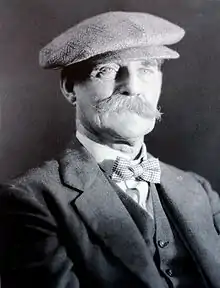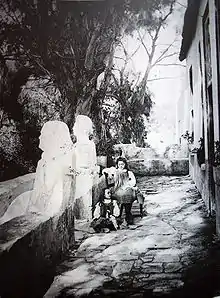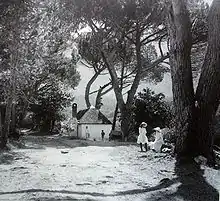
Arthur Elliott (1870, New York City – 20 November 1938, Cape Town), was a South African photographer who recorded the architecture and daily life of the Cape. Elliott took over 10,000 photographs of Cape Dutch architecture, creating an unrivalled pictorial record of early 20th century buildings at the Cape.[1][2][3]
Life

Elliott was born in New York City in 1870.[4] He was orphaned at 12 years old and lived in England and India before arriving in South Africa at the age of 30.[5] He tried his hand at various jobs such as scene-painter and production manager at the Luscombe Searelle Acting Company in Johannesburg.[6][7]
Elliott died in Cape Town on November 30, 1948.[8]
Work


Elliott ended up in Cape Town as a war refugee in 1900 and took to photography, which became a life passion.[5] His home in Cape Town is commemorated by a plaque at 134 Long Street.[9][10] He had a number of major exhibitions in Cape Town ; in 1910, 1913 (with a catalogue compiled by Theal and F.K. Kendall's article on Cape architecture), in 1926 (with an introduction by Sir George Cory, the historian),[11][12] another in 1930, arranged by W.R. Morrison.[13] His final exhibition, in 1938, was titled "The Cape, Quant and Beautiful” and included a catalogue edited by Victor de Kockin.[14] These gave him widespread recognition and enabled him to eke out a living through the selling of prints.
Elliott seems to have been determined to record as much as he was able of the old farmhouses, buildings and streets that were rapidly disappearing with the ever-growing pressure to modernize. During his lifetime only a portfolio of some of his images was published for the use of schools, but in 1969 he authored selection of his best images, showing farmsteads and historic buildings, with an introduction and annotations by Hans Fransen.[15] Before his death, Elliott offered his collection of photographs to the local government for £5000; the offer was declined.[16] After his death, his collection was acquired by the Government and presented to the Cape Archives.[2] A further 1,000 photographs from the collection of W.R. Morrison were added later. The Elliott Collection, as his set of images came to be called, has been used extensively by authors writing about all aspects of old Cape architecture.[17][18]
Bibliography
- Laidler, P. W. Arthur Elliott, a Sentimental Appreciation. Cape Town.
- Lighton, C. Arthur Elliott; a Memoir of the Man and the Story of his Photographic Collection. Cape Town, 1956.[19]
- Architectural Beauty of the Cape as seen by Arthur Elliott – Hans Fransen (Balkema, Cape Town 1969)
References
- ↑ Vivian Bickford-Smith (16 May 2016). The Emergence of the South African Metropolis: Cities and Identities in the Twentieth Century. Cambridge University Press. pp. 160–. ISBN 978-1-107-00293-7.
- 1 2 Nicholas Coetzer (22 April 2016). Building Apartheid: On Architecture and Order in Imperial Cape Town. Taylor & Francis. pp. 52–. ISBN 978-1-317-17103-4.
- ↑ S.A. Archives Journal. South African Society of Archivists. 1959.
- ↑ Turner Browne; Elaine Partnow (1 January 1983). Macmillan biographical encyclopedia of photographic artists & innovators. Macmillan. ISBN 978-0-02-517500-6.
- 1 2 Don Pinnock (2009). The Woman who Lived in a Tree: And Other Perfect Strangers. Jacana Media. pp. 266–. ISBN 978-1-77009-692-9.
- ↑ Charles T. C. Taylor (1968). The history of Rhodesian entertainment, 1890-1930. Collins.
- ↑ Mendel Kaplan; Marian Robertson (1991). Founders and followers: Johannesburg Jewry, 1887-1915. Vlaeberg Publishers. ISBN 978-0-947461-09-6.
- ↑ South African Libraries. 1939.
- ↑ Desmond Martin (25 April 2013). Walking Long Street. Penguin Random House South Africa. pp. 39–. ISBN 978-1-4323-0175-0.
- ↑ John Muir (3 October 2013). Walking Cape Town: Urban walks and drives in the Cape Peninsula. Penguin Random House South Africa. pp. 83–. ISBN 978-1-920545-77-2.
- ↑ Lantern. Adult Education Division, Union Education Department. 1970.
- ↑ Reginald Frank Kennedy (1965). Africana Repository: Notes for a Series of Lectures Given to the Hillbrow Study Center from March to May 1964. Juta.
- ↑ René Ferdinand Malan Immelman (1970). Libraries and people: essays offered to R. F. M. Immelman. C. Struik.
- ↑ ""Captured on camera": A historical and archival appreciation of the Arthur Elliott Collection" (PDF). ifla.org.
- ↑ Arthur Elliott (1969). Architectural Beauty of the Old Cape As Seen by Arthur Elliott; Photos. of Houses and Farmsteads Now Largely Demolished Or Ruined, Taken At the Beginning of the Twentieth Century. Selected, annotated and with an introduction by Hans Fransen.
- ↑ Vincent Rokitta van Graan (3 October 2013). Cape Town Then and Now. Penguin Random House South Africa. pp. 18–. ISBN 978-1-920545-92-5.
- ↑ Gabi Meyer (1984). Research resources in Cape Town: a guide. Centre for African Studies, University of Cape Town. ISBN 9780799205541.
- ↑ Gunilla Malm (2003). Toward an archaeology of buildings: contexts and concepts. Archaeopress. ISBN 978-1-84171-552-0.
- ↑ Conrad Lighton (1956). Arthur Elliott: A Memoir of the Man and the Story of His Photographic Collection. A.A. Balkema.